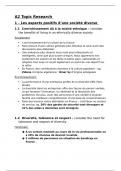VERIFIED 100% CORRECT!!
Qualitative research uses _______________ sampling methods Answer- non
probability
Non probability sampling methods Answer- purpose, convenience, voluntary
response, snowball
Case study Answer- a comprehensive description of a patient's history, current
status, and response to intervention
Narrative discourse/Conversation analysis Answer- Researchers describe the lives
of individual, collect and tell stories about people lives and write narratives about
people lives.
Ethnography Answer- the researcher describes a culture from the perspective of an
insider or those who belong to that culture
Phenomenology Answer- The researcher describes the participants' lived
experience and gives a voice to their viewpoint about a phenomenon, situation, or
condition
Grounded theory Answer- The researcher explains the phenomenon being studied
through the analysis of relationships among concepts.; develops research
hypotheses to explain what is happening and perhaps why
Methods for collecting data in qualitative research study Answer- interviews,
observations, artifacts
Which of the following sampling methods DOES NOT apply when selecting subjects
to participate in a qualitative research study?
A. Uses randomized sampling methods where subjects are selected randomly from
the general population
B. Uses a combination of purposive and snowball sampling techniques to select
subjects
C. Uses purposive sampling where subjects are not selected randomly but rather for
a specific purpose
D. Uses convenience sampling where subjects are selected from a group of people
that are easy to contact or reach. Answer- A. Uses randomized sampling methods
where subjects are selected randomly from the general population
, T/F: Some of the arguments AGAINST using qualitative research designs are that
they use a more flexible approach and can explain phenomena not easily explained
or revealed with numbers and ordinal data. Answer- False
Which of the following are TRUE about qualitative study designs?
A. Uses the subject's own words and narrative summaries of observable behavior to
express data, not numbers
B. Relies on words and images
C. Must be tied to understanding, explanation, or the development of theory about an
observed phenomenon
D. Relies on numerical and ordinal data Answer- A. Uses the subject's own words
and narrative summaries of observable behavior to express data, not numbers
B. Relies on words and images
C. Must be tied to understanding, explanation, or the development of theory about an
observed phenomenon
T/F: Some drawbacks or challenges with qualitative research studies are that they
can be more time consuming and the results are challenging to replicate. Answer-
True
Which type of mixed methods design is this?
Researchers are studying in-home caregivers' confidence of caring for a person post
stroke. They administer a caregiver's confidence assessment scale in conjunction
with personal interviews to see if the participants' views agree with the survey
results. Answer- Convergent mixed methods design
______ design involves collecting quantitative and qualitative data at the same time
Answer- convergent mixed methods
With _______ design, quantitative data is collected first and then qualitative data is
collected to explain the quantitative results Answer- explanatory sequential mixed
methods
_______ design involves collecting qualitative data first to explore the topic, and then
collecting quantitative data to measure the variables indicated by the qualitative data
Answer- exploratory sequential mixed methods
Clients with TBI were interviewed to get their views on their ability to go shopping at
the grocery store. Findings were analyzed and then a survey was developed to
determine what factors posed the greatest barriers to grocery shopping.
This is an example of which sequential mixed methods design Answer- exploratory
Which type of mixed methods design is this?
Therapists are given a survey (based on a Likert scale) about their competency
training patients to use assistive technology. Afterwards, the therapists participate in







